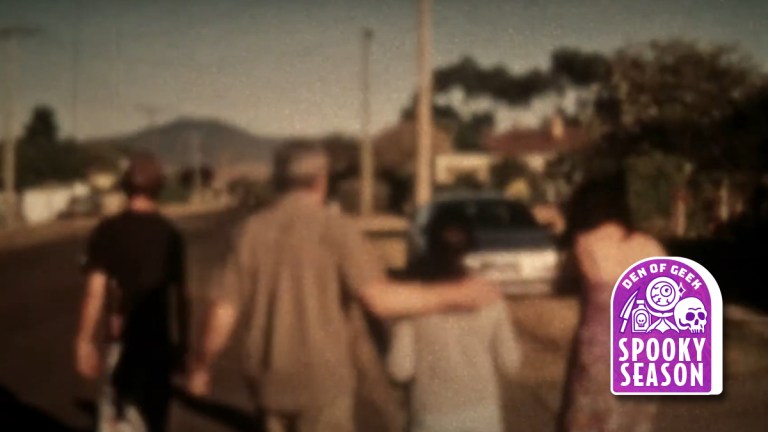Lake Mungo: The Lingering Mystery Behind One of Australia’s Scariest Horror Films
Director Joel Anderson made one perfect film and then disappeared from the film world. We explore the enigma of Lake Mungo.

“We were thinking it’d be nice if we could make a film that was kind of a curiosity, but if you saw it years from now you wouldn’t know anything about where it came from.”
This quote from a 2009 interview with Lake Mungo director Joel Anderson proved to be strangely prescient. Anderson was speaking ahead of the film’s screening at the Brisbane Film Festival – the movie had already premiered at the Sydney Film Festival, played South by Southwest in the US, and would go on to tour several more festivals before eventually finding its way onto DVD.
Anderson conducted a few interviews. He talked about how the film had in part come about because he wanted to make something cheap and manageable that could be shot in sections because he’d had trouble getting financing for a different, bigger, more expensive movie he’d written a script for. And then he effectively disappeared from the film world altogether, with the only credit listed on his IMDb page after Lake Mungo (his feature debut) being a short called Gravity (with Paperclip) from 2013. It’s a mildly amusing riff on Alfonso Cuarón’s Gravity, imagining Sandra Bullock talking to ‘Clippy’ the paperclip, Microsoft’s notoriously irritating animated Office Assistant. It’s a wilfully outdated reference point even in 2013 – the short refers specifically to Windows 98 and the Clippy feature was completely removed by 2008.
IMDb says Anderson co-wrote the short with eight other people. The short itself credits “Mr Worm.” Is this Anderson’s work? Impossible to know, and if it is, it’s just another weird punchline in the story of a haunting movie shrouded in mystery.
Before we continue we should point out that we can’t offer any answers as to why Anderson is off the grid. The latest we know – via another journalist friend – is that Anderson just doesn’t want to be interviewed, and while we reached out to Martin Sharpe who plays Matthew in Lake Mungo, we never heard back. It somehow adds to the mythology of a film that’s had ripple effects well beyond its own sphere.
Lake Mungo plays like a documentary – talking heads relate the story of what happened to the Palmer family after the death of 16-year-old Alice Palmer (Talia Zucker), who drowned in a dam while swimming with her brother. Her father identifies the body but strange sightings suggest that perhaps Alice’s ghost is haunting the family – or perhaps Alice isn’t dead at all? The movie contains several setups and reveals – you think you’re watching one kind of story but soon discover you’re watching another.
First and foremost, Lake Mungo is a movie about grief. “The idea of someone in your family or someone you care for dying, and being in a tragedy, is the one thing I think everyone fears most,” said Anderson, and it’s the senselessness and lack of control the family feels immediately after the tragedy that starts the story.
What’s incredibly striking about Lake Mungo is how naturalistic it is. The movie was unscripted, relying on the cast to improvise much of the dialogue which is told through to-camera interviews, while Anderson himself played the off screen interviewer. Some cast members found it easier than others, according to Anderson, though in the finished film it doesn’t show. Performances across the board are entirely believable, and while the family members – Alice’s father Russell (David Pledger), mother June (Rosie Traynor), and brother Matthew (Martin Sharpe) – do the heavy lifting, along with Ray (Steve Jodrell), the psychic whom Alice, we discover, was also seeing before she died, there are also multiple other characters including friends of Alice, neighbors, police and people from the area who may have caught glimpses of Alice after her death. It’s an effective way to build up a picture of the town of Ararat, including its darker side.
It’s surely no coincidence that the family are named the Palmers – Lake Mungo has more than a few things in common with David Lynch’s Twin Peaks. Not only does the troubling image of Alice’s body once it’s been fished out of the dam, days after she went missing, recall that of the iconic shot of Laura Palmer’s corpse wrapped in plastic, but the acceptable face of Ararat has a seamy side, just like Twin Peaks.
In Lake Mungo we discover that the sightings of Alice aren’t real, and the images from the house that Matthew had recorded on the cameras he set up to watch for her were faked – by him – in order to convince his mother to exhume Alice’s corpse and prove to her once and for all that Alice is really dead – or at least so he says. But Matthew captures something else – footage of the Palmers’ neighbor Brett in Alice’s bedroom, apparently searching for something.
Alice used to babysit for Brett’s children and what he’s searching for in Alice’s room is a VHS tape of a sex act between Alice, Brett, and his wife. Alice, just like Laura, had secrets. There’s more than a shade of Peaks’ Doctor Jacoby about psychic Ray too, a man to whom Alice revealed her deepest fears and her sense of impending doom.
“I feel like something bad is going to happen to me. I feel like something bad has happened to me, it hasn’t reached me yet but it’s on its way. And it’s getting closer.” These are the ominous words that open the film, spoken by Alice to Ray and this is the path that plays out in Lake Mungo, the terrible, awful inevitable tragedy at the heart of the story.
While it is a story about grief, Lake Mungo is also deeply terrifying. Alice is troubled by visions of drowning, of feeling cold and wet and alone, of wandering the corridors of her own home with her mother unable to see her, and eventually she’s haunted by an apparition.
Mungo’s money shot occurs on a trip Alice takes with her friends to dry lake and national heritage site Lake Mungo. Footage taken on her boyfriend’s phone one night shows Alice separating from the group and burying something under a tree. When the family take a trip to Lake Mungo to try to find whatever it was Alice buried they discover a package of her belongings – her watch, a favorite bracelet, and her phone. And when they watch the final footage on that phone…
What single shot from a movie do you find legitimately scary?? 😳
— A Spooky Story (@ASpookyStory) September 28, 2023
My pick: the freeze frame from the phone scene in Lake Mungo. Shit still gives me chills https://t.co/xqixv7MUXZ pic.twitter.com/ElrB7bkTJa
So much of Lake Mungo is about foreshadowing, but also wrong footing – we think we know what’s going on, but we don’t – until this moment, when we really do. By the time we get the horrifying reveal of a shambling figure approaching Alice in the dark, getting closer and closer, we know exactly what we are going to see, and it’s unbearable. Alice is haunted by herself, by her own future, the face of her own drowned body coming towards her inexorably.
Yes, Lake Mungo is about grief, the grief experienced by the family and how they eventually come to terms with it, believing Alice only wanted the family to know her true self and has now moved on, but for Alice it’s about something much darker.
The Palmer women are secretive, we learn. June’s mother could never truly connect with June, and she, in turn, was never fully able to give herself to Alice. So Alice kept her secrets and suffered with her premonitions alone, talking only to Ray who ultimately couldn’t – or didn’t – help her.
Alice’s story is incredibly sad. It’s the story of a troubled 16-year-old, with friends who didn’t really know her, in a dubious sexual relationship with an older couple that she hadn’t told anyone about. A girl having horrifying visions of her own death who couldn’t really talk to her family about any of it. And a girl whose visions came true.
Worse still, after her family finds closure they pack up the house and move on, believing Alice has done the same. But mid credits images show us that, no, Alice’s ghost remains, it’s just that her family can’t see her. Just like the parallel visions that she and her mother had while talking to Ray – June in the house believing that Alice isn’t there, Alice in the house knowing that her mother can’t see her – both see their version of the future, a psychic vision shared between mother and daughter, but ultimately they fail to connect.
Premonitions of one’s own death are not a new thing in fiction. In A Christmas Carol Scrooge is presented with a vision of his own depressing funeral and neglected tombstone, but Scrooge has the chance to change his ways. In Alice’s case there’s a terrible inevitability. Something bad is going to happen. Something bad has happened. It’s getting closer.
The location of Lake Mungo has significance too. It’s a place of archeological importance, where the oldest human remains found in Australia were discovered. It is a place of clear connection between past, present, and future – tangible evidence of deaths that occurred thousands of years ago resonating far into the future.
Lake Mungo might be a low budget Australian curio from over a decade ago but its legacy in the world stretches wide. The movie retains a Rotten Tomatoes score of 96%. In recent study The Book of Horror: The Anatomy of Fear in Film by Matt Glasby, published in 2020, Lake Mungo was picked out as one of the scariest movies ever.
The film has some high profile fans too – American horror author Paul Tremblay, who wrote A Head Full Of Ghosts, The Cabin At The End Of The World, and Survivor Song, says his very scary 2016 novel Disappearance at Devil’s Rock was partly inspired by the movie.
“In addition to being truly, bone-deep terrifying, it’s a movie about the awe and vastness of grief,” he told us. “One that honestly confronts horror’s ultimate question: what happens to us when we die.”
And more horror fans all over the world discover Lake Mungo every day.
Anderson might have walked away from the movie world (for now at least?) but his beautiful, chilling movie has a life of its own. That he got his wish and no one really knows much about where it came from or where he went is all part of the enigma.
